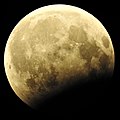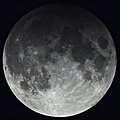June 2029 lunar eclipse
| Total lunar eclipse June 26, 2029 | |
|---|---|
Ecliptic north up The moon will pass through the center of the Earth's shadow. | |
| Saros (and member) | 130 (35 of 72) |
| Gamma | +0.01240 |
| Magnitude | +1.84362 |
| Duration (hr:mn:sc) | |
| Totality | 1:41:53 |
| Partial | 3:39:32 |
| Penumbral | 5:35:08 |
| Contacts (UTC) | |
| P1 | 0:34:34 |
| U1 | 1:32:18 |
| U2 | 2:31:18 |
| Greatest | 3:22:05 |
| U3 | 4:13:01 |
| U4 | 5:11:50 |
| P4 | 6:09:42 |
A total lunar eclipse will take place between Monday and Tuesday, June 25-26, 2029. A central total eclipse lasting 1 hour and 41 minutes 53 seconds will plunge the full Moon into deep darkness, as it passes right through the centre of the Earth's umbral shadow. While the visual effect of a total eclipse is variable, the Moon may be stained a deep orange or red color at maximum eclipse. It will be able to be seen from most of the Americas, Western Europe and Africa. The partial eclipse will last for 3 hours and 39 minutes 32 seconds in total.
The moon will pass through the center of the Earth's shadow. Totality will last 101 minutes 53 seconds, the maximum duration for Saros series 130.
With an umbral eclipse magnitude of 1.84362, this is the largest lunar eclipse of the 21st century. Gamma has a value of only 0.01240. Due to the Moon's relatively large size as seen from Earth and greater speed in its elliptical orbit, totality will not last over 106 minutes. This is the darkest and greatest total lunar eclipse in the 21st century.
Visibility
[edit]It will be completely visible over South America, seen rising over North America, and setting over Africa and Europe.
Related lunar eclipses
[edit]Lunar year series
[edit]| Lunar eclipse series sets from 2027–2031 | ||||||||
|---|---|---|---|---|---|---|---|---|
| Ascending node | Descending node | |||||||
| Saros | Date Viewing |
Type Chart |
Gamma | Saros | Date Viewing |
Type Chart |
Gamma | |
| 110 | 2027 Jul 18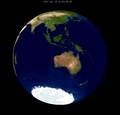
|
Penumbral
|
-1.57589 | 115 | 2028 Jan 12
|
Partial
|
0.98177 | |
| 120 | 2028 Jul 06
|
Partial
|
-0.79040 | 125 | 2028 Dec 31
|
Total
|
0.32583 | |
| 130 | 2029 Jun 26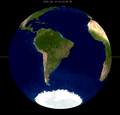
|
Total
|
0.01240 | 135 | 2029 Dec 20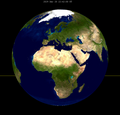
|
Total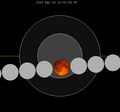
|
-0.38110 | |
| 140 | 2030 Jun 15
|
Partial
|
0.75346 | 145 | 2030 Dec 09
|
Penumbral
|
-1.07315 | |
| 150 | 2031 Jun 05
|
Penumbral
|
1.47322 | |||||
| Last set | 2027 Aug 17 | Last set | 2027 Feb 20 | |||||
| Next set | 2031 May 07 | Next set | 2031 Oct 30 | |||||
Metonic series
[edit]The Metonic cycle repeats nearly exactly every 19 years and represents a Saros cycle plus one lunar year. Because it occurs on the same calendar date, the Earth's shadow will be in nearly the same location relative to the background stars.
| Ascending node | Descending node |
|---|---|
|
|

|

|
Saros series
[edit]Lunar saros series 130, repeating every 18 years and 11 days, has a total of 71 lunar eclipse events including 56 umbral lunar eclipses (42 partial lunar eclipses and 14 total lunar eclipses). Solar Saros 137 interleaves with this lunar saros with an event occurring every 9 years 5 days alternating between each saros series.
| Greatest | First | |||
|---|---|---|---|---|
 The greatest eclipse of the series will occur on 2029 Jun 26, lasting 102 minutes.[1] |
Penumbral | Partial | Total | Central |
| 1416 Jun 10 | 1560 Sep 4 | 1921 Apr 22
|
1957 May 13
| |
| Last | ||||
| Central | Total | Partial | Penumbral | |
2083 Jul 29
|
2155 Sep 11 | 2552 May 10 | 2678 Jul 26 | |
| 1903 Apr 12 | 1921 Apr 22 | 1939 May 3 | |||

|

|

|

|

|

|
| 1957 May 13 | 1975 May 25 | 1993 Jun 4 | |||

|

|

|

|

|

|
| 2011 Jun 15 | 2029 Jun 26 | 2047 Jul 7 | |||

|

|

|

|

|

|
| 2065 Jul 17 | 2083 Jul 29 | ||||

|
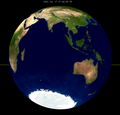
|

|

| ||
Inex series
[edit]The inex series repeats eclipses 20 days short of 29 years, repeating on average every 10571.95 days. This period is equal to 358 lunations (synodic months) and 388.5 draconic months. Saros series increment by one on successive Inex events and repeat at alternate ascending and descending lunar nodes.
This period is 383.6734 anomalistic months (the period of the Moon's elliptical orbital precession). Despite the average 0.05 time-of-day shift between subsequent events, the variation of the Moon in its elliptical orbit at each event causes the actual eclipse time to vary significantly. It is a part of Lunar Inex series 40.
All events in this series shown (from 1000 to 2500) are central total lunar eclipses.
| Descending node | Ascending node | Descending node | Ascending node | ||||
|---|---|---|---|---|---|---|---|
| Saros | Date | Saros | Date | Saros | Date | Saros | Date |
| 95 | 1016 May 24 | 96 | 1045 May 3 | 97 | 1074 Apr 14 | 98 | 1103 Mar 25 |
| 99 | 1132 Mar 3 | 100 | 1161 Feb 12 | 101 | 1190 Jan 23 | 102 | 1219 Jan 2 |
| 103 | 1247 Dec 13 | 104 | 1276 Nov 23 | 105 | 1305 Nov 2 | 106 | 1334 Oct 13 |
| 107 | 1363 Sep 23 | 108 | 1392 Sep 2 | 109 | 1421 Aug 13 | 110 | 1450 Jul 24 |
| 111 | 1479 Jul 4 | 112 | 1508 Jun 13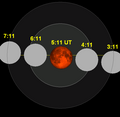
|
113 | 1537 May 24 | 114 | 1566 May 4 |
| 115 | 1595 Apr 24 | 116 | 1624 Apr 3 | 117 | 1653 Mar 14 | 118 | 1682 Feb 21 |
| 119 | 1711 Feb 3 | 120 | 1740 Jan 13 | 121 | 1768 Dec 23 | 122 | 1797 Dec 4 |
| 123 | 1826 Nov 14 | 124 | 1855 Oct 25 | 125 | 1884 Oct 4 | 126 | 1913 Sep 15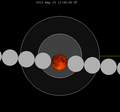
|
| 127 | 1942 Aug 26
|
128 | 1971 Aug 6
|
129 | 2000 Jul 16
|
130 | 2029 Jun 26
|
| 131 | 2058 Jun 6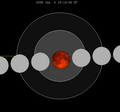
|
132 | 2087 May 17
|
133 | 2116 Apr 27 | 134 | 2145 Apr 7 |
| 135 | 2174 Mar 18 | 136 | 2203 Feb 26 | 137 | 2232 Feb 7 | 138 | 2261 Jan 17 |
| 139 | 2289 Dec 27 | 140 | 2318 Dec 9 | 141 | 2347 Nov 19 | 142 | 2376 Oct 28 |
| 143 | 2405 Oct 8 | 144 | 2434 Sep 18 | 145 | 2463 Aug 29 | 146 | 2492 Aug 8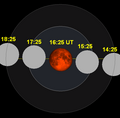
|
Tritos
[edit]- Preceded: Lunar eclipse of July 27, 2018
- Followed: Lunar eclipse of May 26, 2040
Tzolkinex
[edit]- Preceded: Lunar eclipse of May 16, 2022
- Followed: Lunar eclipse of August 7, 2036
Half-Saros cycle
[edit]A lunar eclipse will be preceded and followed by solar eclipses by 9 years and 5.5 days (a half saros).[2] This lunar eclipse is related to two annular solar eclipses of Solar Saros 137.
| June 21, 2020 | July 2, 2038 |
|---|---|

|

|
See also
[edit]Notes
[edit]- ^ Listing of Eclipses of cycle 130
- ^ Mathematical Astronomy Morsels, Jean Meeus, p.110, Chapter 18, The half-saros
External links
[edit]- 2029 Jun 26 chart: Eclipse Predictions by Fred Espenak, NASA/GSFC

